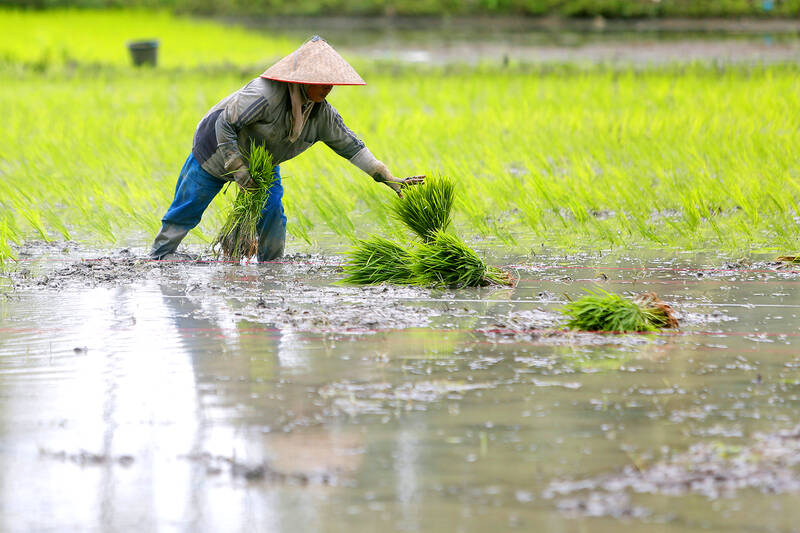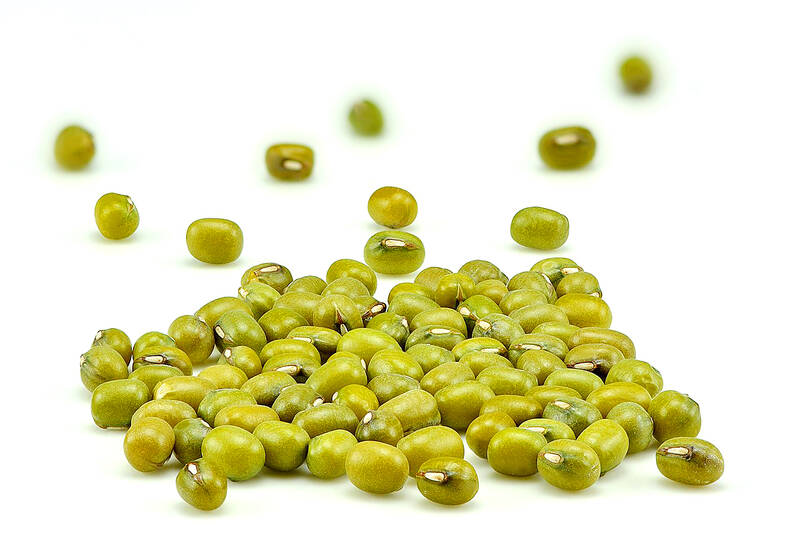They are one of the easier legumes to digest and fetch a higher crop price than wheat, yet mung beans are not mainstream in the western world. But, while the vigna radiata has been nourishing populations across India and Asia for millennia, in recent decades enterprising scientists have started investigating the legume’s potential to improve food security and farmers’ incomes.
Since its inception 50 years ago, the World Vegetable Centre (also known as WorldVeg) in Tainan has collected more than 8,000 “accessions,” or varieties, of mung bean seeds, genebank manager, Maarten van Zonneveld, says. Much like other species, such as humans and dogs, plants — including mung beans — need genetic diversity to create robust offspring. Diversity also enables selective crossing of different varieties to create new lines with desirable traits.
CHALLENGES

Photo: EPA-EFE
Like many of the best things in life, growing the mung bean — also known as moong bean, green gram, golden gram, black gram and Jerusalem pea — has its challenges.
Shanice Van Haeften, is a mung bean researcher at the University of Queensland. Once, while teaching a primary school science workshop in the farming region of Queensland’s Western Downs region, a student told her: “Oh yeah, my dad calls them mongrel beans because we tried to plant them and they didn’t grow well.”
Van Haeften, who completed a fellowship at WorldVeg last year, says mung bean crops can be “kind of wild and hard to manage,” and sensitive to pests, diseases and the weather (biotic and abiotic stresses, in more scientific terms).

Photo courtesy of Wikimedia Commons
But at the International Mungbean Improvement Network (Imin), led by WorldVeg with partners including the Australian Center for International Agricultural Research (ACIAR), new varieties are being bred to overcome many of the trials that have plagued farmers.
GROWING A BETTER BEAN
In the case of mung beans, careful screening has revealed varieties with greater resistance to pathogens like powdery mildew, anthracnose and fusarium wilt, and pests such as cowpea aphid, thrips and stem fly. A wild beach variety could help breed lines that can tolerate salinity and improved lines have shortened the bean’s growing time.
“We have got varieties that mature in 50 days,” the regional director of Imin in South and Central Asia, Dr Ramakrishnan Nair, says. This makes mung beans — one of the only summer rotation options among legumes — ideal to plant between other crops such as rice or wheat, enriching the soil with nitrogen and supplementing smallholder farmers’ incomes.
Van Zonneveld says: “So, if you have your short season mung bean, it helps you diversify and if some other crop fails it still gives you some return.”
And although mung beans already have high heat tolerance, Nair says they’ve even been able to improve that.
“One of our lines will be released very soon in Tajikistan where the temperatures go up to 45C.”
In Australia, Van Haeften says mung beans are one of the highest value grain crops, attracting about US$1,100 a ton — three times higher than wheat. Currently 90 percent is exported to India and broader Asia, but she thinks demand will increase domestically. The CSIRO has predicted that Australia’s retail plant protein market will skyrocket from US$150 million in 2019 to US$6 billion by 2030.
“The plant-based market is meant to just completely explode, and even further by 2050,” says Van Haeften. “So even though mung bean isn’t a major crop now, I think it has the potential to grow exponentially.”
Not only do mung beans contain the myriad nutritional benefits of legumes in general, as a rich source of protein, fibre, antioxidant polyphenols and essential vitamins and minerals, they also have a few special qualities.
SPECIAL QUALITIES
Mung beans are easy to digest, for instance — good news if you suffer from bloating after eating beans. That not only makes them a less embarrassing choice for people with sensitive guts, it also makes their protein more available to the body. In Bangladesh, Nair says, people mix mung bean powder with milk powder to make a nutritious, tummy-friendly drink for children.
They are also low in phytates, the compounds in legumes that can reduce absorption of iron, a vital nutrient that is commonly deficient in developed and developing countries. In one of Nair’s projects exploring varieties with enhanced nutritional properties, he says researchers discovered a line that takes up more than double the iron from good soil, which they are crossing with improved lines to help address malnutrition in Kenya, Tanzania and Uganda.
In traditional Chinese medicine, mung beans are believed to have a cooling effect on the body, and have been used for thousands of years to treat fever and heatstroke as well as other conditions including hypertension, gastrointestinal problems and inflammation. This belief is baring out in research.
“The seed coat has got some goodies,” says Nair, “like two compounds particularly which help to reduce the body’s heat.”

In the March 9 edition of the Taipei Times a piece by Ninon Godefroy ran with the headine “The quiet, gentle rhythm of Taiwan.” It started with the line “Taiwan is a small, humble place. There is no Eiffel Tower, no pyramids — no singular attraction that draws the world’s attention.” I laughed out loud at that. This was out of no disrespect for the author or the piece, which made some interesting analogies and good points about how both Din Tai Fung’s and Taiwan Semiconductor Manufacturing Co’s (TSMC, 台積電) meticulous attention to detail and quality are not quite up to

April 21 to April 27 Hsieh Er’s (謝娥) political fortunes were rising fast after she got out of jail and joined the Chinese Nationalist Party (KMT) in December 1945. Not only did she hold key positions in various committees, she was elected the only woman on the Taipei City Council and headed to Nanjing in 1946 as the sole Taiwanese female representative to the National Constituent Assembly. With the support of first lady Soong May-ling (宋美齡), she started the Taipei Women’s Association and Taiwan Provincial Women’s Association, where she

Chinese Nationalist Party (KMT) Chairman Eric Chu (朱立倫) hatched a bold plan to charge forward and seize the initiative when he held a protest in front of the Taipei City Prosecutors’ Office. Though risky, because illegal, its success would help tackle at least six problems facing both himself and the KMT. What he did not see coming was Taipei Mayor Chiang Wan-an (將萬安) tripping him up out of the gate. In spite of Chu being the most consequential and successful KMT chairman since the early 2010s — arguably saving the party from financial ruin and restoring its electoral viability —

It is one of the more remarkable facts of Taiwan history that it was never occupied or claimed by any of the numerous kingdoms of southern China — Han or otherwise — that lay just across the water from it. None of their brilliant ministers ever discovered that Taiwan was a “core interest” of the state whose annexation was “inevitable.” As Paul Kua notes in an excellent monograph laying out how the Portuguese gave Taiwan the name “Formosa,” the first Europeans to express an interest in occupying Taiwan were the Spanish. Tonio Andrade in his seminal work, How Taiwan Became Chinese,